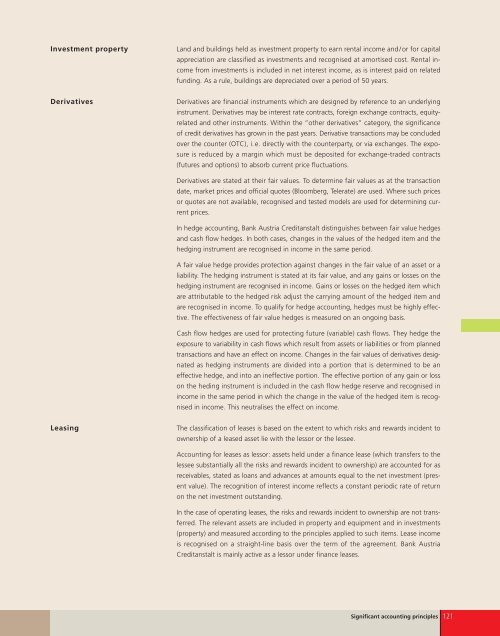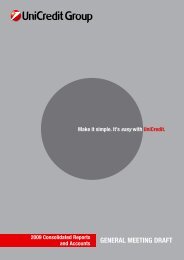team spirit - Bankier.pl
team spirit - Bankier.pl
team spirit - Bankier.pl
Create successful ePaper yourself
Turn your PDF publications into a flip-book with our unique Google optimized e-Paper software.
Investment property<br />
Derivatives<br />
Leasing<br />
Land and buildings held as investment property to earn rental income and/or for capital<br />
appreciation are classified as investments and recognised at amortised cost. Rental income<br />
from investments is included in net interest income, as is interest paid on related<br />
funding. As a rule, buildings are depreciated over a period of 50 years.<br />
Derivatives are financial instruments which are designed by reference to an underlying<br />
instrument. Derivatives may be interest rate contracts, foreign exchange contracts, equityrelated<br />
and other instruments. Within the “other derivatives” category, the significance<br />
of credit derivatives has grown in the past years. Derivative transactions may be concluded<br />
over the counter (OTC), i.e. directly with the counterparty, or via exchanges. The exposure<br />
is reduced by a margin which must be deposited for exchange-traded contracts<br />
(futures and options) to absorb current price fluctuations.<br />
Derivatives are stated at their fair values. To determine fair values as at the transaction<br />
date, market prices and official quotes (Bloomberg, Telerate) are used. Where such prices<br />
or quotes are not available, recognised and tested models are used for determining current<br />
prices.<br />
In hedge accounting, Bank Austria Creditanstalt distinguishes between fair value hedges<br />
and cash flow hedges. In both cases, changes in the values of the hedged item and the<br />
hedging instrument are recognised in income in the same period.<br />
A fair value hedge provides protection against changes in the fair value of an asset or a<br />
liability. The hedging instrument is stated at its fair value, and any gains or losses on the<br />
hedging instrument are recognised in income. Gains or losses on the hedged item which<br />
are attributable to the hedged risk adjust the carrying amount of the hedged item and<br />
are recognised in income. To qualify for hedge accounting, hedges must be highly effective.<br />
The effectiveness of fair value hedges is measured on an ongoing basis.<br />
Cash flow hedges are used for protecting future (variable) cash flows. They hedge the<br />
exposure to variability in cash flows which result from assets or liabilities or from <strong>pl</strong>anned<br />
transactions and have an effect on income. Changes in the fair values of derivatives designated<br />
as hedging instruments are divided into a portion that is determined to be an<br />
effective hedge, and into an ineffective portion. The effective portion of any gain or loss<br />
on the heding instrument is included in the cash flow hedge reserve and recognised in<br />
income in the same period in which the change in the value of the hedged item is recognised<br />
in income. This neutralises the effect on income.<br />
The classification of leases is based on the extent to which risks and rewards incident to<br />
ownership of a leased asset lie with the lessor or the lessee.<br />
Accounting for leases as lessor: assets held under a finance lease (which transfers to the<br />
lessee substantially all the risks and rewards incident to ownership) are accounted for as<br />
receivables, stated as loans and advances at amounts equal to the net investment (present<br />
value). The recognition of interest income reflects a constant periodic rate of return<br />
on the net investment outstanding.<br />
In the case of operating leases, the risks and rewards incident to ownership are not transferred.<br />
The relevant assets are included in property and equipment and in investments<br />
(property) and measured according to the princi<strong>pl</strong>es ap<strong>pl</strong>ied to such items. Lease income<br />
is recognised on a straight-line basis over the term of the agreement. Bank Austria<br />
Creditanstalt is mainly active as a lessor under finance leases.<br />
Significant accounting princi<strong>pl</strong>es 121
















